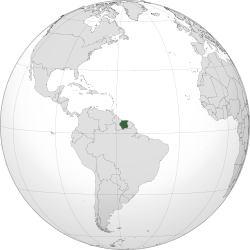History of the Jews in Suriname
The history of the Jews in Suriname starts at least in the 17th century, when in 1639, the English government allowed Spanish and Portuguese Jews from the Netherlands, Portugal and Italy to settle the region, coming to the old capital Torarica. In 1652, a new group that migrated under the leadership of Francis Willoughby, 5th Baron Willoughby of Parham came to Suriname [1] and settled in the Jodensavanne area. A third group came 1664, after their expulsion from Recife and then French Guiana, led by David Cohen Nassy.[2] According to the Encyclopedia of Latin America, "Suriname was one of the most important centers of the Jewish population in the Western Hemisphere, and Jews there were planters and slaveholders."[3]


Part of a series on the |
|---|
| History of Suriname |
 |
|
|
|
The plantation economy of the Jodensavanne—an area of savannah that was settled and planted with sugarcane—relied on slave labour. The community declined in the wake of the French Cassard expedition in 1712 and the levies he instituted, competition from beet sugar, and a revolt by Maroons. Settlers relocated to the capital of Paramaribo. They returned to the synagogue in the Jodensavanne to celebrate the holidays until 10 September 1832, when a fire destroyed the village and synagogue. The savanna area was subsequently overtaken with jungle regrowth.[4]
Background
Although in the present day the term Creole (as used in the context of Suriname) means a synonym of Afro-Surinamese, its original meaning carried a negative connotation to mean that a white European person had forgotten how to be a "good Jew" (or proper Englishman, etc.) due to having adopted some characteristics that European communities considered "native".[5] Jews did interact with other groups in Suriname and the illegitimate children of Jewish males with Afro-Surinamese women were raised as Jews and given Jewish names.
Some Jewish family names have endured and are now considered Afro-Surinamese family names and the names of the Saramaka clan of Maroons refer to the Jewish plantation owners their ancestors escaped from. In the cemeteries of Paramaribo Jewish tombstones appear alongside creole ones.[5]
Identity can be used to exclude persons from a community, but it can also be used to force people to be part of community against their will. During the 17th and 18th centuries forced inclusion was commonplace in both the Portuguese and High German Jewish communities and the rigid identity boundaries were often supported by legislation. Though the cultural identity of Portuguese Jews was defined as being a white colonial elite, this identity existed alongside an aggressive policy to include poor and Jews of color.[5]
Synagogues
Three synagogues were built in Suriname: Beracha Ve Shalom in 1685, in the Jodensavanne; Neveh Shalom Synagogue in 1719, built by Ashkenazi Jews in the new capital of Paramaribo; and Zedek ve Shalom in 1735, built by Sephardic Jews.[4] There was also a Darkhe Yesharim for Judeo-African creoles.[6]
Depopulation
Most Jews left Suriname when it was granted independence in 1975 and others left during the civil war of the 1980s.[4] About 130 Jewish community members remained in a combined Sephardic and Ashkenazic congregation at Neve Shalom (which includes community hall and mikveh). The second synagogue was rented for use as a computer service shop, its furniture and art loaned to the Israel Museum in Jerusalem.
In the 1990s, the jungle growth in the Jodensavanne was cleared, 450 graves uncovered and the ruins of the synagogue maintained.[4] In a 21st-century census, 181 entered "Judaism" as their religion, out of a total population of 560,000.[7]
See also
References
- Francis, Lord Willoughby
- Herschthal, Eric (17 August 2006). "A Star Historian Opens a New Chapter". The Jewish Daily Forward. Retrieved 29 November 2011.
- Encyclopedia of Latin America: Amerindians through The Age of Globalization (Prehistory to the Present). J. Michael Francis, Facts On File. New York, N.Y. 2010, p. 296,
- The Surprising Discovery of Suriname’s Jewish Community by Jacob Steinberg, 2008 Kulanu
- Vink, W., 2010. Creole Jews: negotiating community in colonial Suriname. BRILL.
- Jewish Sanctuary in the Atlantic World: A Social and Architectural History by Barry L. Stiefel
- "Definitieve Resultaten Achtste Algemene Volkstelling" (PDF). ALGEMEEN BUREAU VOOR DE STATISTIEK - SURINAME. Archived from the original (PDF) on 2015-09-24.
External links
- Haruth.com – "Jews in Suriname"

